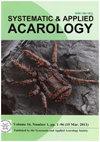Development and reproduction of four predatory mites (Parasitiformes: Phytoseiidae) feeding on the spider mites Tetranychus evansi and T. urticae (Trombidiformes: Tetranychidae) and the dried fruit mite Carpoglyphus lactis (Sarcoptiformes: Carpoglyphidae)
IF 1.3
3区 农林科学
Q2 ENTOMOLOGY
引用次数: 0
Abstract
The tomato red spider mite, Tetranychus evansi, a notorious crop pest, invaded New Zealand in 2020. In an effort to identify potential biological control agents for this species, we investigated the capabilities of four phytoseiid predators found in New Zealand—Amblyseius herbicolus, Amblyseius lentiginosus, Amblydromalus limonicus, and Neoseiulus californicus. For comparison, we also used the two-spotted spider mite, T. urticae, and the dried fruit mite, Carpoglyphus lactis, as prey for these predators. In our first experiment we monitored immature development and oviposition rate (over the first 5 days) of the phytoseiid predators when presented with the three prey species. While all four species of predators could develop and reproduce on the factitious (alternative and easily available) prey species C. lactis, they had limited success when feeding on T. evansi and T. urticae. Amblyseius herbicolus, A. lentiginosus, and Amblyd. limonicus were unable to reach adulthood when feeding on T. evansi and T. urticae in the presence of the protective webbing spun by the mites. While N. californicus matured when exposed to T. evansi reared on black nightshade leaves, it did not lay eggs—indicating potential limitations in prey suitability. In our second experiment, gravid females of all four predators failed to maintain their reproduction when provided with T. evansi in the presence of webbing. Neoseiulus californicus exhibited phenotypic plasticity in its developmental time, body size, and oviposition rate when feeding on the three prey species. This suggests that N. californicus has the flexibility to switch diets to survive during food scarcity, especially when their primary prey, T. urticae, is limited. This study is also the first to offer life history information about A. lentiginosus. Our findings underscore the difficulties of controlling T. evansi using phytoseiid predators and highlight the need for diversified pest management strategies, including the use of alternative insect predators or entomopathogenic fungi.以蜘蛛螨(Tetranychus evansi 和 T.urticae,Trombidiformes: Tetranychidae)和干果螨(Carpoglyphus lactis,Sarcoptiformes: Carpoglyphidae)为食的四种捕食螨(寄生螨目:Phytoseiidae)的发育和繁殖情况
番茄红蜘蛛(Tetranychus evansi)是一种臭名昭著的农作物害虫,于 2020 年入侵新西兰。为了确定该物种的潜在生物控制剂,我们调查了在新西兰发现的四种植毛螨捕食者的能力--Amblyseius herbicolus、Amblyseius lentiginosus、Amblydromalus limonicus 和 Neoseiulus californicus。为了进行比较,我们还使用了双斑蜘蛛螨(T. urticae)和干果螨(Carpoglyphus lactis)作为这些捕食者的猎物。在第一个实验中,我们监测了植食性天敌在遇到这三种猎物时的未成熟发育情况和产卵率(头 5 天)。虽然所有四种捕食者都能在假性(可供选择且容易获得的)猎物 C. lactis 上发育和繁殖,但它们在捕食 T. evansi 和 T. urticae 时却很难成功。Amblyseius herbicolus、A. lentiginosus 和 Amblyd. limonicus 在取食有螨类编织的保护网的 T. evansi 和 T. urticae 时无法达到成年。虽然加州蛱蝶在接触到黑夜来香叶上饲养的 T. evansi 时会成熟,但它并不产卵--这表明猎物适宜性的潜在限制。在我们的第二个实验中,当有蛛网存在时,所有四种捕食者的怀孕雌性都无法维持繁殖。加州霓虹鳉在捕食三种猎物时,在发育时间、体型和产卵率方面都表现出了表型可塑性。这表明加州蛱蝶在食物匮乏时,尤其是当其主要猎物荨麻蝇数量有限时,可以灵活地转换食物以求得生存。这项研究也是首次提供有关A. lentiginosus的生活史信息。我们的研究结果凸显了使用植食性天敌控制 T. evansi 的困难,并强调了多元化害虫管理策略的必要性,包括使用替代性昆虫天敌或昆虫病原真菌。
本文章由计算机程序翻译,如有差异,请以英文原文为准。
求助全文
约1分钟内获得全文
求助全文
来源期刊

Systematic and Applied Acarology
ENTOMOLOGY-
CiteScore
2.20
自引率
33.30%
发文量
152
期刊介绍:
Systematic and Applied Acarology (SAA) is an international journal of the Systematic and Applied Acarology Society (SAAS). The journal is intended as a publication outlet for all acarologists in the world.
There is no page charge for publishing in SAA. If the authors have funds to publish, they can pay US$20 per page to enable their papers published for open access.
SAA publishes papers reporting results of original research on any aspects of mites and ticks. Due to the recent increase in submissions, SAA editors will be more selective in manuscript evaluation: (1) encouraging more high quality non-taxonomic papers to address the balance between taxonomic and non-taxonomic papers, and (2) discouraging single species description (see new special issues for single new species description) while giving priority to high quality systematic papers on comparative treatments and revisions of multiple taxa. In addition to review papers and research articles (over 4 printed pages), we welcome short correspondence (up to 4 printed pages) for condensed version of short papers, comments on other papers, data papers (with one table or figure) and short reviews or opinion pieces. The correspondence format will save space by omitting the abstract, key words, and major headings such as Introduction.
 求助内容:
求助内容: 应助结果提醒方式:
应助结果提醒方式:


